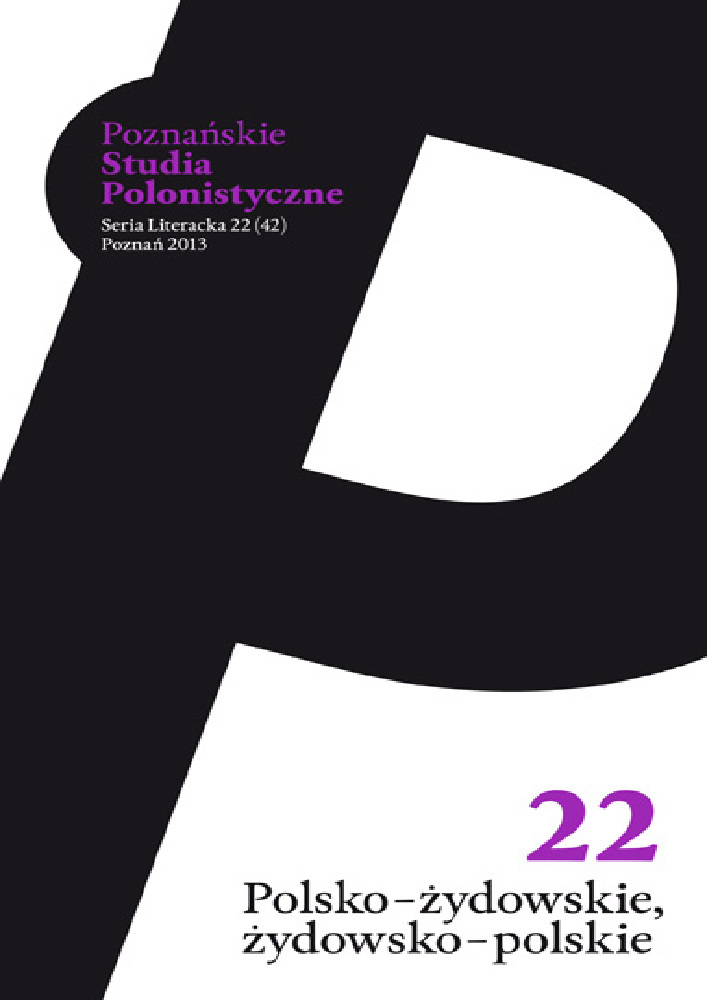Abstract
Representation of various modes, forms, symptoms and degrees of mental illnesses, frequent in The Street of Crocodiles, are analysed in two perspectives: psychological and literary-cultural. Using the tools of modern psychology, the article interprets the pathological symptoms of Touya, Maria, aunt Agatha, and various other characters, most importantly the advancing illness of father Joseph, who displays symptoms of schizophrenia. Schulz uses a language filled with metaphors, blurring the border between symptoms of illness and metaphors, between the imaginary and the real, and between health and illness, norm and pathology, between the human and the animal. Schulz’s representation of madness opposes the modern understanding, which is dominated by analytical, rationalist identification of an illness, related to a socially determined norm of mental health. It brings back the premodern quality to madness, which becomes a divine phenomenon, related to the pagan rite of fertility, to the “orgy of life” and Dionysian element, and to Freudian life drive. Dionysius and Freud meet in an area independent from the rules of culture and reason: the return to nature, including the nature in a human being. Here, madness becomes a “basic figure” and “the ultimate ur-schema”, as they belong to the unintellectual, basic, ecstatic sphere. This is related to the imperative of penetration of areas that threaten the “balance of the soul”, to address the topic that shows “the scar of removal”, and forces us to ask the question of limits of humanity.
References
Cioran E., Na szczytach rozpaczy, przeł. I. Kania, Warszawa 2007.
Foucault M., Historia szaleństwa w dobie klasycyzmu, przeł. H. Kęszycka, wstęp M. Czerwiński, Warszawa 1987.
Foucault M., Powiedziane, napisane. Szaleństwo i literatura, wybór, oprac. T. Komendant, przeł. B. Banasiak et al., posłowie M.P. Markowski, Warszawa 1999.
Jarzębski J., Wstęp, w: B. Schulz, Opowiadania. Wybór esejów i listów, oprac. J. Jarzębski. Wrocław 1989.
Jaspers M.T., Taurodontism in the down syndrome, „Oral Surgery, Oral Medicine, Oral Pathology” 1981, t. 51, z. 6.
Kępiński A., Schizofrenia, Kraków 2001.
Madejska N., Malarstwo i schizofrenia, Kraków 1975.
Matthews-Brzozowska T., Walasz J., Matthews Z., Zespół Downa – wczesna terapia ortodontyczna płytką Castillo-Moralesa, „Nowiny Lekarskie” 2009 (78), z. 3–4.
Pueschel S.M., Clinical Aspects of Down Syndrome from Infancy to Adulthood, „American Journal of Medical Genetics” 1990, supl. 7.
Schulz B., Opowiadania. Wybór esejów i listów, oprac. J. Jarzębski. Wrocław 1989.
Seligman M.E.P., Walker E.F., Rosenhan D.L., Psychopatologia, przeł. J. Gilewicz, A. Wojciechowski, Poznań 2003.
Sheppard R., Problematyka modernizmu europejskiego, przeł. P. Wawrzyszko, w: Odkrywanie modernizmu. Przekłady i komentarze, red. R. Nycz, Kraków 2004.
Sikorska-Wiśniewska G., Nadwaga i otyłość u dzieci i młodzieży, „Żywność. Nauka. Technologia. Jakość” 2007, z. 6 (55).
License
Authors
Authors of texts accepted for publication in „Poznańskie Studia Polonistyczne. Seria Literacka” are required to complete, sign and return to the editor's office the Agreement for granting a royalty-free license to works with a commitment to grant a CC sub-license.
Under the agreement, the authors of texts published in „Poznańskie Studia Polonistyczne. Seria Literacka” grant the Adam Mickiewicz University in Poznań a non-exclusive, royalty-free license and authorize the use of Attribution-NoDerivatives 4.0 International (CC BY-ND 4.0)Creative Commons sub-license.
The authors retain the right to continue the free disposal of the work.
Users
Interested Internet users are entitled to use works published in „Poznańskie Studia Polonistyczne. Seria Literacka” since 2016, for non-commercial purposes only, under the following conditions:
- attribution - obligation to provide, together with the distributed work, information about the authorship, title, source (link to the original work, DOI) and the license itself.
- no derivatives - the work must be preserved in its original form, without the author's consent it is not possible to distribute the modified work, such as translations, publications, etc.
Copyrights are reserved for all texts published before 2016.
Miscellaneous
Adam Mickiewicz University in Poznań retains the right to magazines as a whole (layout, graphic form, title, cover design, logo etc.).
